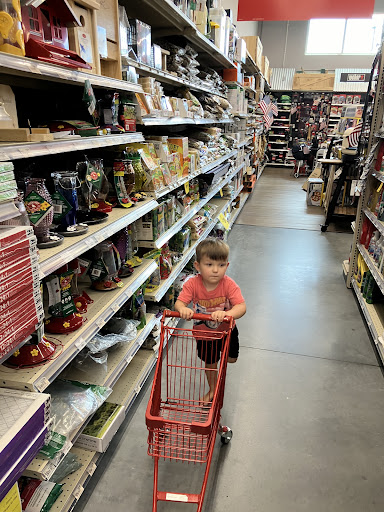How much to exchange propane tank near me Smart 1 Save
Why Propane Exchange Costs Matter for Your Grilling Season
When you’re Googling “how much to exchange propane tank near me,” it usually means the burgers are prepped but the grill is silent. In most of coastal South Carolina, a standard 20-pound tank swap runs about $20–$28 depending on the retailer and the season. That flat fee buys speed: you hand over an empty, walk away with a full cylinder, and dinner’s back on track.
Why does the price range matter? Because the choice you make every time the tank runs dry affects your wallet, your schedule, and even how much propane you actually receive. Exchange services are quick but often under-fill to roughly 15 lb. Refill stations take a few extra minutes, yet they typically put 16 lb back into the same cylinder for noticeably less money per gallon.
The helpful team at Lowcountry Ace on James Island has guided countless neighbors through these options. Below you’ll find a streamlined look at costs, pros, cons, and safety tips so you can decide—fast—whether to exchange or refill before the next cookout.
Understanding Propane Exchange vs. Refill Costs
At its core, the difference is simple: exchanges charge a flat fee for a pre-filled tank, while refills charge per gallon for exactly what’s added to yours. If you’re new to propane, a quick read through the Propane entry will explain why the fuel must be filled to only 80 % of a cylinder’s capacity.
| Factor | Propane Exchange | Propane Refill |
|---|---|---|
| Average Cost | $20–$28 flat fee | $2–$5 per gallon |
| Convenience | Grab-and-go | Requires attendant |
| Time | ≈ 5 minutes | 10–15 minutes |
| Propane Received | ≈ 15 lb (75 %) | ≈ 16 lb (80 %) |
| Tank Ownership | Swap for another | Keep your own |
A completely empty 20-lb cylinder holds about 4.6 gallons. If propane is $3.25 / gal, a refill costs roughly $15, versus $24 for an exchange—yet you walk away with more fuel.
For neighborhood-specific numbers, see our guide on Propane Exchange James Island Cost or Cost to Refill Propane Tank James Island.
The Great Debate: Exchanging vs. Refilling Your Propane Tank
When you’re wondering how much to exchange propane tank near me, you’re really asking a bigger question: should you exchange or refill? This debate has been going on in backyards across America for years, and honestly, both sides have great points.
The choice isn’t just about money – though that’s certainly part of it. It’s about what matters most to you: convenience or value. Are you someone who wants to get back to grilling as quickly as possible, or do you prefer to squeeze every penny out of your propane dollar?
Your grilling habits play a huge role in this decision. If you fire up the grill once a month during summer, convenience might win. But if you’re grilling multiple times a week, those savings from refills really add up over time.
The condition of your tank also matters. If you’ve got a newer tank that you trust, refilling makes sense. But if your tank is getting rusty or you’re not sure about its safety certification, exchanges give you peace of mind with regularly inspected tanks.
The Case for Convenience: Advantages of Propane Exchange
Let’s be honest – sometimes you just want to grab a tank and get grilling. That’s where propane exchanges shine brightest. When you’re hosting a barbecue and find your tank is empty, speed becomes everything.
The exchange process is beautifully simple. You leave your empty tank outside the store, walk in, pay the cashier, and swap it for a full tank from the cage. No waiting around for an attendant to show up, no watching them slowly fill your tank, no small talk about the weather. You’re in and out in under five minutes.
Wide availability is another huge advantage. You can find exchange services at gas stations, grocery stores, and hardware stores almost everywhere. Planning a camping trip? You can grab a tank on the way. Grilling at your beach house? There’s probably an exchange location nearby.
Safety is where exchanges really shine. These tanks undergo regular inspection and certification by the exchange companies. You don’t have to worry about whether your tank is expired, rusty, or unsafe. Someone else handles all that responsibility for you.
The consistent experience across locations is surprisingly valuable. Once you know how to exchange a tank at one place, you can do it anywhere in the country. It’s the same process whether you’re in Charleston or California.
For a step-by-step walkthrough of how easy the process really is, check out our guide on How Do You Exchange Propane Tanks?
The Value Proposition: Advantages of Propane Refills
Now, if you’re someone who likes to get the most bang for your buck, refills are probably calling your name. The math is pretty compelling when you break it down.
Cost-effectiveness is the biggest draw. Refills typically cost 30-50% less than exchanges when you calculate the price per gallon. A typical refill runs $10-$15 compared to $22-$30 for an exchange. For frequent grillers, that difference adds up to real money over a season.
Here’s something that might surprise you: exchange tanks typically contain only 15 pounds of propane (75% of a 20-pound tank’s capacity), while refills can provide up to 16 pounds (80% capacity). You’re literally getting more grilling time per transaction with refills.
The pay-only-for-what-you-need aspect is brilliant. If your tank is half full, you only pay to top it off. With exchanges, you pay the full price whether your tank had 1 pound or 10 pounds left in it.
Tank ownership has its perks too. When you refill, you keep your own tank. You know its history, you can maintain it properly, and you avoid the frustration of getting a beat-up tank from an exchange.
Many refill stations offer bulk discounts if you have multiple tanks or come in regularly. If you’ve got tanks for your grill, fire pit, and patio heater, those savings can be substantial.
Find quality refill services in your area with our Propane Refills Near Me guide.
How Much to Exchange a Propane Tank Near Me: The Process and What to Expect
A 60-Second Walk-Through of a Propane Exchange
- Park and drop your empty beside the outdoor exchange cage—never carry cylinders inside.
- Pay the cashier. They stamp your receipt so the attendant knows you’ve purchased a swap.
- Swap cylinders. The attendant opens the cage, places your empty inside, and hands you a full, inspected tank.
- Secure the new tank upright in your vehicle, and you’re out the door.
Total time: often under five minutes. That’s the appeal.
What Happens During a Refill
- An attendant inspects your cylinder for rust, dents, and expiration date.
- The tank is weighed, then connected to the dispenser.
- It’s filled to the 80 % safety limit (≈ 16 lb for a grill tank).
- You pay only for the gallons added, and you keep your own tank.
This takes 10–15 minutes, but the savings (and extra propane) are hard to ignore.
Common Tank Sizes, Quickly
- 20 lb (grills, patio heaters) – most exchanged and refilled size.
- 30 lb (RVs, larger grills) – almost always refill-only.
- 100 lb (home heat, food trucks) – refill-only, requires upright transport and careful strapping.
- 1-lb disposable – single-use camping canisters; not refillable.
Knowing your size ensures you arrive at a location that can legally and safely serve you.
Important Safety and Logistical Questions Answered
How Much Propane Is Really in That Tank?
Most exchange cylinders are filled to about 15 lb, while a refill delivers the full 16 lb that represents 80 % capacity. If you’re paying $24 for 15 lb in an exchange cage, that’s roughly $1.60 / lb. A refill at $3.25 / gal works out to about $0.85 / lb—almost half the cost.
Can I Exchange Any Propane Tank?
Exchange programs accept standard 20-lb grill cylinders in good shape. Tanks that are rusty, damaged, or past their certification date are rejected for safety. (Cylinders must be recertified 12 years after manufacture, then every 5–10 years.) Non-standard sizes—30 lb, 40 lb, 100 lb—are handled only by refill stations.
Safe Transportation Basics
- Transport upright and strapped so the cylinder can’t tip.
- Never leave tanks in a hot, closed vehicle for long periods.
- The DOT allows up to 90 lb of propane in a passenger vehicle (no single cylinder over 45 lb).
- Store tanks outside in a shaded, well-ventilated area, away from ignition sources.
Frequently Asked Questions about Propane Exchange and Refills
Where can I find propane exchange and refill services near me?
You’ll see cages or refill stations at hardware stores (including Lowcountry Ace), many gas stations, grocery stores, farm-supply outlets, and warehouse clubs. Hours and prices vary, so it’s smart to call ahead if you’re on a tight schedule. Need options around James Island or Folly Beach? Check our guide to the Cheapest Residential Propane Near Me.
Do propane tanks expire?
Yes. Cylinders are stamped with a manufacture date and require recertification 12 years later. After inspection they receive an “E” (good for 5 years) or “S” (good for 10 years) stamp. Exchange programs handle certification automatically; refill stations will not fill an out-of-date tank.
How can I tell how much propane I have left?
- Hot-water trick: pour warm water down the side; feel for the cool line.
- Weigh it: weight minus tare = pounds of propane (1 gal ≈ 4.2 lb).
- Add a gauge: inline or magnetic styles give at-a-glance readings.
Using any of these methods avoids finding an empty tank mid-BBQ.
Conclusion: Making the Right Choice for Your Propane Needs
The decision between propane exchange and refill ultimately depends on your priorities, grilling habits, and personal preferences. Both options have clear advantages that appeal to different types of users.
Choose Exchange If You:
- Value convenience and speed above all else
- Grill occasionally or seasonally
- Don’t want to worry about tank maintenance or expiration dates
- Need propane while traveling or away from home
- Prefer the simplicity of a flat-rate transaction
Choose Refill If You:
- Want maximum value for your propane dollar
- Grill frequently throughout the year
- Don’t mind spending a few extra minutes for the service
- Want to keep your own tank in good condition
- Use multiple propane appliances
The Numbers Don’t Lie:
For frequent users, refills can save $50-$100 per year compared to exchanges. However, for occasional users, the convenience of exchanges may be worth the extra cost.
Local Considerations:
In the Charleston, James Island, and Folly Beach areas, both services are readily available. Consider your typical usage patterns and choose the option that best fits your lifestyle.
Safety First:
Regardless of which option you choose, always prioritize safety. Follow proper transportation and storage guidelines, and never attempt to modify or repair propane tanks yourself.
Our Recommendation:
For most homeowners who grill regularly, refills provide the best value. For occasional grillers or those who prioritize convenience, exchanges offer best simplicity.
At Lowcountry Ace, we’re committed to helping our community make informed decisions about their propane needs. Whether you choose exchange or refill, we’re here to ensure you get back to grilling safely and efficiently.
For residents in the Charleston, James Island, and Folly Beach areas, the helpful team at Lowcountry Ace can help with quick and easy propane exchanges to get you back to grilling. Visit us at our Riverland Market location on Folly Road for all your propane needs.
Ready to get your propane situation sorted out? Check out our Propane Exchange Near Me guide to find the most convenient option for your next grilling trip.
Lowcountry Ace Hardware: Your one-stop shop for home improvement. We offer quality products from trusted brands and expert advice from our experienced staff. Located on James Island, visit us for tools, hardware, fishing gear, power tools, building materials, grills & smokers, electrical and plumbing supplies, and more.

















